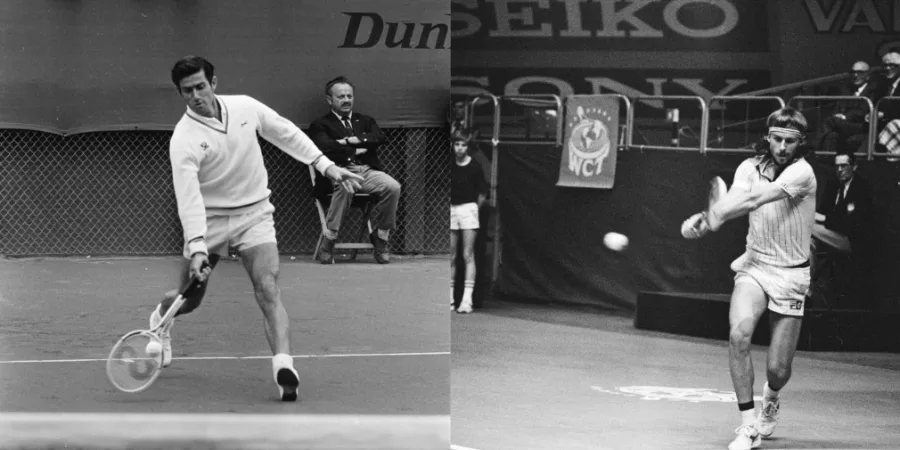
You may have noticed there are still a few tournaments that end in the term cup, like the Rogers Cup, although most tennis tournaments end with the term open.
Furthermore, tennis is not the only sport that uses the phrase open. It’s also utilized for golf, and the rationale behind the term is the same. So why are tennis tournaments called open?
This naming practice is directly related to the open in Open Era, which refers to the pro tennis tournaments era that began in 1968. This was when the tournament was open to professionals competing with amateurs for the first time that year. However, some tennis tournaments are not called open.
There is a considerable amount of fascinating history behind the term open in tennis. Nowadays, the term open is accepted, but few know how it came about.
Here is what to know about why tennis tournaments are called open, what led to the tournaments getting opened, and the events that led to the tennis tournaments getting opened.
All About Why Tennis Tournaments Are Called Open
Only starting in 1968 were professional players allowed to compete in competitions, including Grand Slams, regardless of the level of play. When this occurred, many competitions switched from title championships to open championships.
Previously, pros were not allowed to participate in officially sanctioned events. Only amateur tennis players were permitted. Pros competed in separate, unauthorized tournaments with cash prizes.
The official events became open to all players starting in 1968. The period from 1968 to the present is known as the Open Era. It appears that the name open stuck and was adopted.
There were a few requirements, though:
- Players are assigned to the qualifiers, which they must win to advance to the main draw.
- Participants wouldn’t be entered into the main draw straight away.
- Additionally, tennis players must meet a minimum global ranking requirement in order to enter the qualifying rounds.
It is worth noting that although the term open has stuck, it’s possible that some of the uses of the word are not entirely official.
For example, the official name of the French Open is undoubtedly Roland Garros. Therefore, although it is widely accepted, some tournaments still seem to stick to their original names.
What Led To Tennis Tournaments Being Called Open?

Suppose you’re wondering what changed and led to tennis tournaments being open to everyone. As mentioned above, in 1968, the Open Era in tennis began. Prior to it, professionals were not present in the majority of competitions, including the majors.
Many talented athletes opted to compete as amateurs for this reason. The competitions became open due to the realization that by keeping professionals out, they would be unable to further advance the sport.
Grand Slam competitions agreed to let professionals participate alongside amateurs for the championship, modernizing the sport.
The English were, in fact, the forerunners of this change movement, openly exposing the rampant hypocrisy in the sport, as many athletes pretended to be amateurs while requesting and receiving enormous sums for expenses to compete at the highest level events.
Openly acknowledged professionals, however, were disallowed even though they earned less from the game.
What Were The Events That Led To The Open Era Of Tennis?
At the outset of the Open Era, when tournament organizers began referring to their events as open, they meant that any players, not just the typical amateurs, were welcome to participate.
Before 1968, a group of amateurs, those from the bourgeoisie and above, played competitive tennis for minimal or no pay.
Tennis was typically played just for tennis’ sake in those prestigious tennis competitions. There wasn’t any cash prize for players to win. In fact, players were looked down on for wishing to play for money. The event organizers were simply pleased to exploit the taboo against playing for money.
The situation developed, and more participants joined the fray, many of whom were relatively impoverished than bourgeois. A minority of the participants aspired to go pro and compete for money. Many had their eyes on playing for alternate sponsors, as is the case in sports.
These professionals faced criticism for participating in games for cash, despite how wrong it was to exploit them for their skills without compensation.
In order to uphold their beliefs about the atrocious custom of compensating winners, the elite tennis event organizers forbade them from competing there for nearly three decades, from the post-World War II era until 1968.
When they decided to become professionals, legendary players like Gonzales and Rosewall, among others, were barred from countless Australian Open, Roland Garros, Wimbledon, and U.S. Open competitions.
Due to this, the era’s professionals who could not compete in the Slams typically traveled and played exhibitions while touring as a barnstorming group.
When the majority of these issues were resolved in 1968 and prize money eventually became the norm, those professionals who had been barred from wanting to go pro for cash prizes were permitted to participate in the tournaments, effectively rendering them open. Well after Industrial Revolution, the term open remained.
Amateur tennis players at the time received reimbursement for their costs but never received prize money.
Nowadays, as a result of prize money, amateurs are no longer considered amateurs for the same reasons. Which is why amateurs ceased to be amateurs. Therefore, it is said that tennis professionals no longer play with amateurs.
The British Hard Court Championships, held in April 1968 in Bournemouth, England, was the very 1st open-era competition. The 1968 French Open, held in May, was the 1st open Grand Slam tennis tournament. The 3rd open Grand Slam tennis event that same year was the U.S. Open.
Conclusion
Since tennis professionals had originally been prohibited from competing in tennis competitions, which had been amateur-only events before that time, the inclusion of the term open in the name reflected the fact that the events would now be open to all participants.
Some tennis tournaments still stick to other names, such as Wimbledon.
